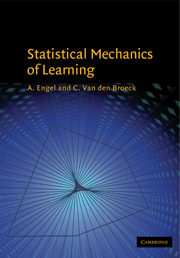Book contents
- Frontmatter
- Contents
- Preface
- 1 Getting Started
- 2 Perceptron Learning – Basics
- 3 A Choice of Learning Rules
- 4 Augmented Statistical Mechanics Formulation
- 5 Noisy Teachers
- 6 The Storage Problem
- 7 Discontinuous Learning
- 8 Unsupervised Learning
- 9 On-line Learning
- 10 Making Contact with Statistics
- 11 A Bird's Eye View: Multifractals
- 12 Multilayer Networks
- 13 On-line Learning in Multilayer Networks
- 14 What Else?
- Appendices
- Bibliography
- Index
12 - Multilayer Networks
Published online by Cambridge University Press: 05 June 2012
- Frontmatter
- Contents
- Preface
- 1 Getting Started
- 2 Perceptron Learning – Basics
- 3 A Choice of Learning Rules
- 4 Augmented Statistical Mechanics Formulation
- 5 Noisy Teachers
- 6 The Storage Problem
- 7 Discontinuous Learning
- 8 Unsupervised Learning
- 9 On-line Learning
- 10 Making Contact with Statistics
- 11 A Bird's Eye View: Multifractals
- 12 Multilayer Networks
- 13 On-line Learning in Multilayer Networks
- 14 What Else?
- Appendices
- Bibliography
- Index
Summary
In the preceding chapters we have described various properties of learning in the perceptron, exploiting the fact that its simple architecture allows a rather detailed mathematical analysis. However, the perceptron suffers from a major deficiency that led to its demise in the late 1960s: being able only to implement linearly separable Boolean functions its computational capacities are rather limited. An obvious generalization is feed-forward multilayer networks with one or more intermediate layers of formal neurons neurons between input and output (cf. fig. 1.1c). On the one hand these may be viewed as being composed of individual perceptrons, so that their theoretical analysis may build on what has been accomplished for the perceptron. On the other hand the addition of internal degrees of freedom makes them computationally much more powerful. In fact multilayer neural networks are able to realize all possible Boolean functions between input and output, which makes them an attractive choice for practical applications. There is also a neurophysiological motivation for the study of multilayer networks since most neurons in biological neural nets are interneurons neither directly connected to sensory inputs nor to motor outputs.
The higher complexity of multilayer networks as compared to the simple perceptron makes the statistical mechanics analysis of their learning abilities more complicated and in general precludes the general and detailed characterization which was possible for the perceptron. Nevertheless, for tailored architectures and suitable learning scenarios very instructive results may be obtained, some of which will be discussed in the present chapter.
- Type
- Chapter
- Information
- Statistical Mechanics of Learning , pp. 209 - 236Publisher: Cambridge University PressPrint publication year: 2001



